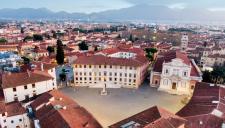PISA, 11th September. The Scuola Superiore Sant’Anna and the Scuola Normale Superiore have come first and second in Italy in the highly accredited THE (Times Higher Education) World University Rankings, published today by this independent British review specialising in the evaluation and comparison of the world's university systems. There are 45 Italian universities included in the ranking, with the Scuola Superiore Sant’Anna in first position and the Scuola Normale Superiore in second place.
In the 2020 ranking – for the benefit of the families of students enrolling in next year's university courses - the university schools of Pisa, united for the last two years in a federation also including the Scuola IUSS of Pavia, are in 149th position in the world (Sant’Anna) and 152nd (the Normale). Both show improved performance, moving up by 4 and 9 positions respectively from the 2019 edition of the THE World University Rankings. This result is even more remarkable at world level, considering that the number of universities included in the ranking has risen from 1258 to 1396, taken from around 90 countries.
Among the parameters contributing to the success of the Scuola Superiore Sant’Anna is that of technology transfer (“Industry Income” parameter), which puts it among the first hundred universities in the world. For its capacity for fostering the creation of spin-off companies, for patents and, in more general terms, for the so-called “third mission” of universities, the Scuola Superiore Sant’Anna is in the 84th position in the world. The Scuola Normale Superiore is placed among the first hundred universities in the world, 72nd, as to the quality of its teaching (Teaching parameter). Also considerable is its improvement regarding the percentage of international students, as well as the increase in citations, bearing testimony to the importance of the research carried out at the Scuola Normale and accounting for the rise by 9 positions in the overall ranking.
The THE World University Rankings system is considered as being among the most eminent and reliable in the world. In addition to technology transfer and level of teaching, THE analysts evaluate the quality of research (“Research”), the impact of scientific citations (“Citations”) and the international nature of the academic staff (“International outlook”), with weighting methods designed to limit the influence of size difference among the universities. The Scuola Superiore Sant’Anna and the Scuola Normale Superiore are inevitably penalised when compared with considerably larger academic institutions: for instance, despite the fact that the number of citations is not standardised on the basis of university size, they are in the first few positions in the world (fourth and fifth, to be precise) in the recent THE ranking of “small universities” .
Joint comment by the rector of the Scuola Superiore Sant’Anna, Sabina Nuti, and the director of the Scuola Normale Superiore, Luigi Ambrosio.
“This THE World University Rankings edition also rewards the quality of our institutions. It is encouraging to note that the universities evaluated continue to increase in number with every edition and that, despite this increase, the Scuola Superiore Sant’Anna and the Scuola Normale Superiore have succeeded in moving up in the ranking: this constitutes a dual success. We are gratified to see the recognition of research quality and of the impact of innovation and technology transfer and hence of the value that these activities represent for student training. The Sant’Anna and the Normale are federated public institutions, differing as to their history but complementing each other from the scientific viewpoint, their distinctive trait being their mission of contributing to the valorisation of merit at all levels, serving as a spur to growth for our ‘Sistema Paese’, or national economic system, and more”.
“University funding in Italy has for years been lagging behind that of countries such as Germany or France. Our entire university system suffers from this chronic underfunding of research. Nonetheless, the fact that the Sant’Anna and the Normale are gaining positions on a par with the best universities in the world and that there are 45 universities of our country in the ranking proves that this hurdle can be overcome. It is to be hoped that our results, and those of other Italian universities, will encourage new budget policies for university training and scientific research”.











